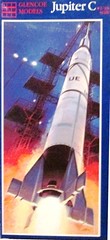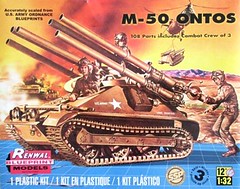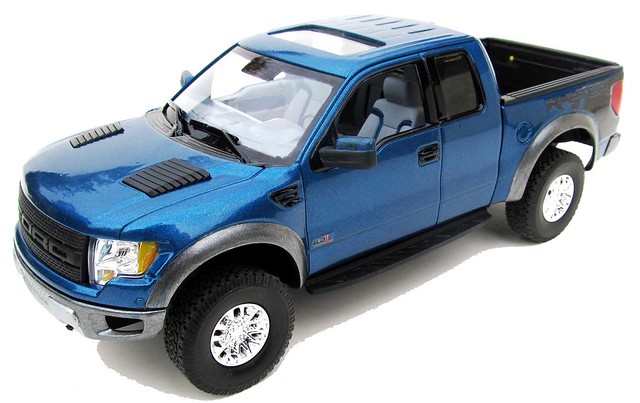Right On Replicas, LLC Step-by-Step Review 20150502*
Jupiter C Rocket 1:48 Scale Glencoe Model Kit #05130 Review
Review and Photos by Robert Byrnes
 The Jupiter-C rocket was originally developed to test the ablative re-entry nose cone of the Jupiter IRBM, although its satellite-launching capabilities were recognized at the time it was designed. Â When used as a satellite launching vehicle, the Jupiter-C is sometimes referred to as the Juno-I.
The Jupiter-C rocket was originally developed to test the ablative re-entry nose cone of the Jupiter IRBM, although its satellite-launching capabilities were recognized at the time it was designed. Â When used as a satellite launching vehicle, the Jupiter-C is sometimes referred to as the Juno-I.
The vehicle consists of a modified Redstone ballistic missile topped by three solid-propellant upper stages. The tankage of the Redstone was lengthened by eight feet to provide additional propellant. The instrument compartment is also smaller and lighter than the Redstone’s. The  second and third stages are clustered in a “tub” atop the vehicle, while the fourth stage is atop the tub itself. The second stage is an outer ring of eleven scaled-down Sergeant rocket engines; the third stage is a cluster of three scaled down Sergeant rockets grouped within. These are held in position by bulkheads and rings and are surrounded by a cylindrical outer shell. The webbed base plate of the shell rests on a ball-bearing shaft mounted on the first-stage instrument section. Two electric motors spin in the tub at a rate varying from 450 to 750 rpm to compensate for thrust imbalance when the clustered motors fire. The rate of spin is varied by a programmer so that it does not couple with the changing resonant frequency of the first stage during flight.
second and third stages are clustered in a “tub” atop the vehicle, while the fourth stage is atop the tub itself. The second stage is an outer ring of eleven scaled-down Sergeant rocket engines; the third stage is a cluster of three scaled down Sergeant rockets grouped within. These are held in position by bulkheads and rings and are surrounded by a cylindrical outer shell. The webbed base plate of the shell rests on a ball-bearing shaft mounted on the first-stage instrument section. Two electric motors spin in the tub at a rate varying from 450 to 750 rpm to compensate for thrust imbalance when the clustered motors fire. The rate of spin is varied by a programmer so that it does not couple with the changing resonant frequency of the first stage during flight.
The upper-stage tub was spun-up before launch. During first-stage flight, the vehicle was guided by a gyro-controlled autopilot controlling both air-vanes and jet vanes on the first stage by means of servos. Following a vertical launch from a simple steel table, the vehicle was programmed so that it was travelling at an angle of 40 degrees from the horizontal at burnout of the first stage, which occurred 157 seconds after launch. At first-stage burnout, explosive bolts fired and springs separated the instrument section from the first-stage tankage. The instrument section and the spinning tub were slowly tipped to a horizontal position by means of four air jets located at the base of the instrument section. When the apex of the vertical flight occurred after a coasting flight of about 247 seconds, a radio signal from the ground ignited the eleven-rocket cluster of the second stage, separating the tub from the instrument section. The third and fourth stages were fired in turn to boost the satellite and fourth stage to an orbital velocity of 18,000 miles per hour.
For the modeler: This is a Skill Level 2 Glencoe 1/48 Scale Jupiter C Rocket model kit #05103 review. Originally released by Hawk Models in 1958, the kit was re-released by Glenco Models in September of 2009. This kit is molded in 60 light gray pieces and comes  with assembly instructions and waterslide decals. The kit also features two launch crew figures and a pocket clip shaped like the completed model. You can still find these kits available at larger hobby stores or online model kit retailers.  When complete, the Jupiter C stands almost 20†tall
with assembly instructions and waterslide decals. The kit also features two launch crew figures and a pocket clip shaped like the completed model. You can still find these kits available at larger hobby stores or online model kit retailers.  When complete, the Jupiter C stands almost 20†tall
Covered in this Review: If you want to perfect your build; basic construction; preparing parts for better finishing; abrasive choices; clamping methods; using Alclad paint for realistic effects; color band masking techniques; using floor polish for decal application; sealing the decals with Pledge Future; fabricating a missing part; clamping methods; finishing the miniature display pin; seam identification and repair; complete paint and adhesive selections and applications; test fitting; constructing and finishing the display base; expanded history and specifications; where “NOT†to use glue; detailing the satellite; are all fully examined in this 17 page, full-color Step-by-Step review in PDF format.
Click the Buy Now link below to purchase the full Step-by-Step review for $4.95 USD.
Important – You MUST click on the “Return to Right on Replicas, LLC” link after you’ve made your purchase to download your review!
Right On Replicas, LLC ©2015 All rights reserved. *All registered trademarks are the property of their respective brands. Follow the manufacturer’s safety recommendations for any product mentioned here.







